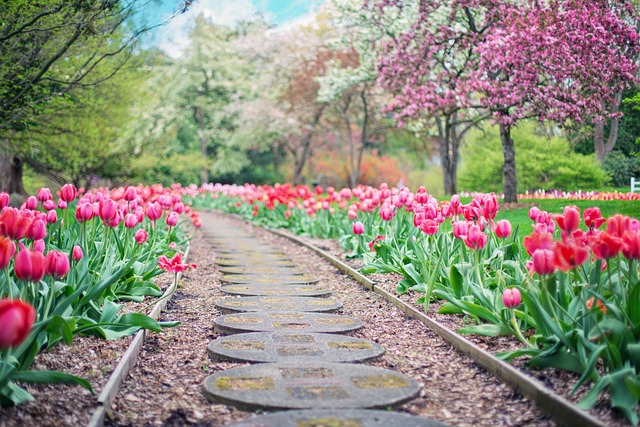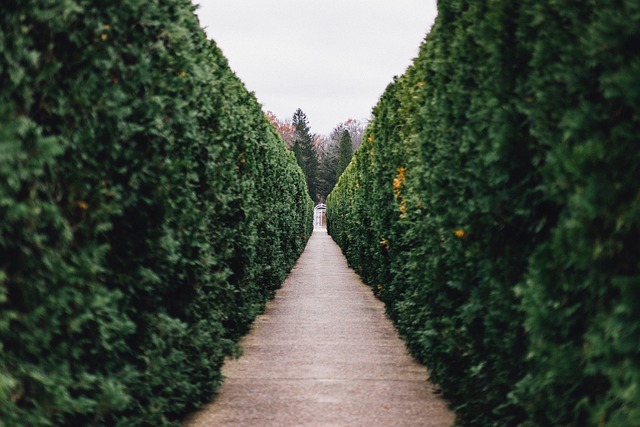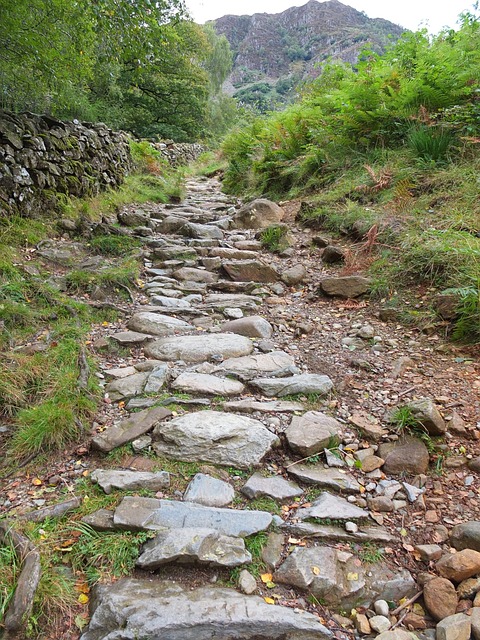Designing a harmonious walkway that integrates seamlessly with the landscape requires careful consideration of environmental respect, user experience, and functional beauty. A successful design includes selecting materials for pathways that complement the natural terrain and plant life, ensuring the walkway feels like a natural extension of the environment. Lighting is crucial for enhancing both safety and visual appeal, especially in the evening when solar lamps or sophisticated lighting schemes can turn walkways into focal points by highlighting their connection to the surrounding greenery. The use of native plants and materials that align with the pathway's character further enhances this synergy, creating a visually pleasing and cohesive environment. Consideration of permeable paving for sustainable water management, pathway alignment for optimal sightlines, and orientation to maximize sunlight all contribute to an effective integration of walkways within landscapes, elevating the outdoor experience from both an aesthetic and functional standpoint. The strategic placement of lighting not only ensures safety but also transforms these spaces into beautiful and usable destinations well into the night, making them more than just pathways—integral and enchanting components of the landscape.
Embark on a journey through the art of seamlessly integrating pathways into landscaping design. This article delves into the harmonious fusion of walkways with surrounding greenery, offering insights through its dedicated sections: “Harmonizing Walkways and Landscapes: Principles of Integration,” “Designing for Flow: Best Practices in Pathway-Landscaping Combinations,” and “Material Matters: Selecting Complementary Surfaces for Walkways and Greenery.” Furthermore, “Lighting the Way: Enhancing both Aesthetics and Functionality with Illuminated Paths” will illuminate innovative approaches to enhancing your outdoor spaces. As you read, consider how these elements can elevate any landscape into a cohesive, inviting, and functional environment.
- Harmonizing Walkways and Landscapes: Principles of Integration
- Designing for Flow: Best Practices in Pathway-Landscaping Combinations
- Material Matters: Selecting Complementary Surfaces for Walkways and Greenery
- Lighting the Way: Enhancing both Aesthetics and Functionality with Illuminated Paths
Harmonizing Walkways and Landscapes: Principles of Integration

The integration of walkways and landscapes is a delicate art that requires careful planning and an understanding of the natural environment as well as the human experience within it. To achieve harmony, the design should consider the pathway as more than mere connectors between points; rather, it should be an integral part of the landscape narrative. The walkway’s material, alignment, and elevation must complement the surrounding terrain and plant life, creating a seamless transition that feels both natural and intentional. For instance, a stone pathway can meander through a garden, its curvature echoing the form of nearby hills or the flow of water in a nearby stream, thus unifying the space.
Lighting plays a crucial role in enhancing the evening ambiance, with options ranging from subtle solar-powered lamps to more elaborate pathway illumination that highlights both the walkway and the plantings it traverses. This integration not only elevates the aesthetic appeal but also ensures safety and usability, making the landscape accessible at all times. By thoughtfully combining elements of design, materials, and lighting, a walkway can become a central feature that enriches the experience of movement through the landscape, creating an environment that is both functional and beautiful.
Designing for Flow: Best Practices in Pathway-Landscaping Combinations

Incorporating a walkway seamlessly into landscape design is an art that requires careful planning and adherence to certain best practices to ensure a cohesive flow between spaces. One key practice involves considering the pathway as an extension of the natural contours of the land, rather than imposing a rigid structure. This approach allows for a more organic integration, often leading to a design that feels both natural and intentional. Utilizing native plants and materials that complement the walkway can further enhance this effect, creating a harmonious transition from one area to another.
Another essential aspect of designing for flow is the careful selection of materials and their textures, which should be consistent with the surrounding environment. The choice of materials not only affects the aesthetic but also the functionality and maintenance of the pathway-landscaping combination. For instance, using permeable paving for the walkway can reduce water runoff and promote eco-friendly landscaping practices. Additionally, considering the width and alignment of the pathway in relation to sightlines and sun paths can significantly improve the usability and visual appeal of the outdoor space.
Material Matters: Selecting Complementary Surfaces for Walkways and Greenery

When designing a harmonious outdoor space, the integration of walkways and greenery is paramount. The selection of materials for pathways should complement both the surrounding landscape and the intended function. Natural stone pavers, for instance, offer a timeless aesthetic that can enhance any garden setting while providing durability and easy maintenance. Their texture and color palette can be chosen to harmonize with the native plants and soil, creating a cohesive look that blurs the boundaries between constructed elements and natural beauty. Additionally, the choice of materials should also consider factors such as permeability and sustainability; porous surfaces allow for better water management and reduce runoff, which is beneficial for both the environment and the longevity of the pathway. Moreover, the tactile qualities of the materials can influence the user’s experience, making each step a sensory journey through the landscape.
Furthermore, the seamless integration of walkways with landscaping extends to the thoughtful arrangement of plants, stones, and lighting along the path. Path lighting, for example, not only ensures safe navigation at night but also accentuates the textures and patterns of both the path material and the plant life above it, creating a serene ambiance that invites exploration. The interplay between light and shadow can transform the atmosphere of an outdoor space, making the environment more inviting and tranquil. In designing walkways, the key is to select materials that not only serve a practical purpose but also enhance the visual and experiential qualities of the landscape they traverse. This thoughtful approach to material selection ensures that the pathway becomes a seamless extension of the natural surroundings, creating an environment that is both functional and aesthetically pleasing.
Lighting the Way: Enhancing both Aesthetics and Functionality with Illuminated Paths

Integrating well-designed lighting into walkways and pathways significantly elevates both the aesthetic appeal and functional aspect of outdoor spaces. The soft glow of ambient lighting not only creates a warm and inviting atmosphere but also ensures safety for users as dusk approaches. Strategically placed luminaries along the pathway can transform an ordinary walking area into a captivating nighttime experience, highlighting landscaping elements such as flower beds, water features, or architectural details, thus enhancing the visual journey through the space. The choice of lighting fixtures and their placement is crucial for both creating the desired ambiance and maintaining the integrity of the surrounding environment. By thoughtfully combining form and function, illuminated paths become a focal point that extends the usability of outdoor spaces into the evening hours, offering homeowners and visitors a safe and enchanting passage under the cover of darkness.
In conclusion, seamlessly integrating pathways with landscaping transforms ordinary walks into inviting journeys through well-designed outdoor spaces. By adhering to the principles outlined in “Harmonizing Walkways and Landscapes,” homeowners and landscape architects can ensure that walkways complement the surrounding greenery, creating a cohesive and aesthetically pleasing environment. The best practices detailed in “Designing for Flow” provide a roadmap for achieving this harmony, emphasizing the importance of considering pathway orientation and landscaping elements to promote an intuitive flow throughout the area.
Selecting the right materials, as discussed in “Material Matters,” is crucial for both functionality and visual appeal, ensuring that the pathway not only stands up to traffic but also blends naturally with its surroundings. Lastly, incorporating strategic lighting as highlighted in “Lighting the Way” enhances both the aesthetics and functionality of illuminated paths, allowing users to enjoy these spaces day and night. Together, these elements contribute to a memorable experience for visitors and homeowners alike, making the outdoor space not just a passageway but an integral part of the landscape’s overall design.
